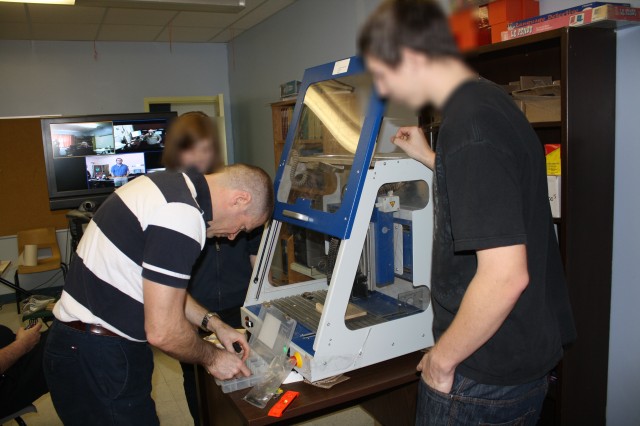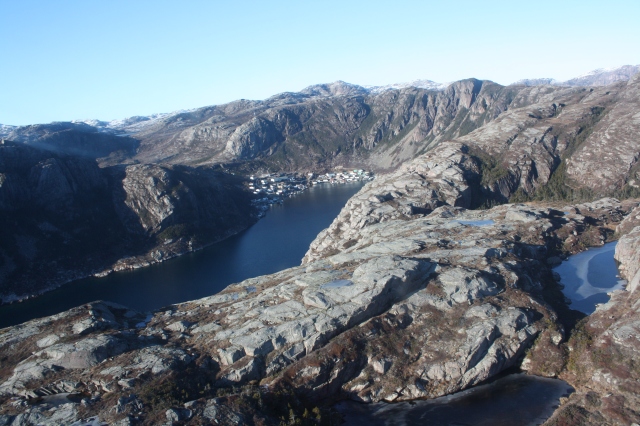Personal Experience: On the Receiving End of Teacher Leadership
In 1983, at the age of 21 I went to work in a small rural school in my hometown as a mathematics-science teacher and was given the grade 12 class as a homeroom as well as a teaching assignment of 11 different full-year courses. Two of the class periods were multi-course; that is, in the same period slot there were students doing both the academic and general streams of mathematics at the same time. It was daunting—think about it; inexperienced and overwhelmed—but, nonetheless, the work got done. The fact that the work got done, in my view, can be credited to three major factors.
First, there’s no doubt that it required a lot of effort. Especially in the first 3-5 years, classroom and lesson preparation dominated everything. I would routinely arrive at school around 7:30 and would leave for home around 5pm. Besides the teaching duties there were the other tasks: preparation, lab management, grading, and, of course, extra-curricular activities. Typically, the job required an additional 3 evenings per week and 3-5 hours on weekends doing additional work. Fortunately for me, at the time, I had no children of my own and so, was able to fit it in.
Second, the student culture at the school was such that this was considered normal. The students were used to the situation and adapted their learning styles accordingly. In short they accepted the fact that there was a lot going on in the classroom and learned to rely as much on themselves and their classmates as they did on their teacher. A healthy degree of independence existed based in need.
Third, and more to the point for this post, the students and teacher were able to function effectively thanks to a host of benefits received from various teacher leadership activities that existed at the time.
Let’s start with the science coordinator. The school district, was a small one. At the time, with a student population a little in excess of 110,000 the province of NL actually had approximately 30 school districts. Since the district was small, the district science coordinator could make the rounds to schools with a decent frequency—once every month or so. Each time he would visit he would make a point of checking in with those of us charged with teaching science and would spend time discussing issues related to curriculum and instruction. To many, this may not seem like a big deal. After all such conversations take place at every school on a daily basis. So much so that most do not even bother to think much about them; they are just a part of the fabric. This case was different. At the school, only two of us had responsibilities in science from grades 7-12. Both of us were ‘shared’—that is we taught more than science. Overall, then, there was not much room for many voices chiming in the subject of science teaching, to say the least! Those visits were vital; a lifeline. Once every month or so there was the chance to talk with someone more experienced about a host of issues that I definitely needed help with.
We can move on to the Association-Sponsored events. In those days the provincial teachers’ professional association had very strong and active special interest councils (SICs). At the time I was a member of both the Mathematics and Science SIC. In addition to the written correspondence the related activity generated, every two years or so the membership would host a general meeting. These were typically two-day events. Sometimes they spanned two work days and sometimes they were shared—one workday and one weekend; Friday and Saturday. It was not cheap to attend them. Teachers in rural schools have to travel to these events, attending these not only put you out the attendance fee, but also you had to find money for travel and accommodation. Sometimes the district was able to offer assistance in the form of substitute teachers or perhaps subsidize part of the admission fee. The professional association was also generous with those willing to offer sessions—if you agreed to put together a session for the event you often got a partial break with your travel expenses. Despite the out-of-pocket costs, though, attendees tended to find the events well worth it. Now, here’s the surprising part: the benefits most felt were not really from attending the sessions. While the sessions were no-doubt useful, the real benefits were not really on the agenda. Face it: teachers like to socialize and to share advice and resources—but on their own terms. In that way those face-to-face gatherings were an absolute treasure from the standpoint of being ways in which you could interact and learn from others in a way that everyone was comfortable with. Most of this happened informally. Small groups meeting in the lobby by people who decided they’d rather do that than attend a formal session; chance encounters on breaks; conversations over a beer after hours—that sort of thing proved to be a significant part of growth as a professional. These would not have happened were it not for the face to face events organized by the SICs.
Now let’s consider the efforts of a supportive community. In my own case, as the teaching career progressed I became more and more a part of a community of physics teachers. As more of a generalist—recall I taught 11 different courses—and a teacher from a small school, I was by no means a ‘major player.’ I was, however, lucky enough to be associated with some peers who were more than generous with their time and talent. Several professors from MUN’s physics department, Harvey Weir, Des Walsh and Cy Snook come to mind, saw outreach to the k-12 community as a vital part of their own professional activities and organized or hosted many related events that I was able to partake in. Of course there was always Frank Shapleigh. These days, Frank is known more for his leadership in the area of Tech. Ed. But in those days he was also hugely active in Physics, particularly in, as he put it, “Lighting a few fires” to get us physics teachers more up to date in our lab activities. In particular his sustained push to get digital interfacing into the mainstream of high-school science lab had a profound effect on my professional activities throughput my whole career.
Finally, let me consider one particular mentorship. In 1992, after 9 years spent in the position I was seconded as a ‘physics-math instructor’ with the province’s new distance education program. Besides teaching mathematics, which I had lots of experience with, I was also expected to be one of two provincial physics instructors. I had considerably less experience with that. t was not that I was un-prepared. The undergraduate degree was in physics and math; I had specialized in science teaching when I did my B. Ed; I had specialized in science curriculum and instruction for my Master’s degree; I had also thought physics in my previous position. Besides, I am a science geek. The year before becoming seconded, for example, I had totally converted my physics labs so that the data collection was totally done through digital interfacing. I had even fabricated my own photogates and connection boxes (from Vernier Kits, if anyone’s interested). But, I was still a generalist at heart. In my small school you could offer, at most, one section of either grade 11 or grade 12 physics per year. Never both. I was not, in my opinion, therefore. a ‘physics teacher’ as such but was expected to be one.
Fortunately the other physics teacher had a wealth of experience and was more than willing to share. It was my good fortune that Lloyd Gill and I shared an office from 1992 to 1997. At the time Lloyd had over 25 years of experience to my nine and, what’s more, Lloyd was a ‘physics teacher’ in the true sense of the work; for most of those years the majority of his teaching load was from grade 11 and grade 12 physics. Now, the relationship was not totally parasitic. Lloyd did not seem to mind having a young techno-geek around—I had my uses I suppose. That period of my life was, though, thanks to Lloyd’s mentorship a growth period like no other. On a daily basis I was able to interact with someone whose knowledge of the subject matter, pedagogic inventory and most important, patience and wisdom, were far in excess of mine. That period was like getting another M.Ed.
Teacher Leadership—A Clarification
Whenever you are part of a conversation on the subject of Teacher Leadership the focus tends to move into the realm of department heads and on the role they play in schools. As part of a generally-accepted frustration with the amount of effort required to play this role effectively the talk tends to stray into various tasks that just plain must be done. These typically are the top three: coordination of assessment/evaluation, setting and enforcement of policy and stocking and otherwise maintaining the labs (or doing whatever other support work that needs to be done). The talk then generally goes on to how there’s not enough time in the day to get this done well and how the financial rewards are meager to the point of probably not being worth it.
It is important to suggest, though, that the ‘Big Three’ noted above are, perhaps, not really all that big on the scale of teacher leadership at all. Some are clerical; the proofing of tests, for example and the remainder—the lab duties, assignment of responsibilities, writing and enforcement of policy—are management tasks, not leadership at all.
So what is leadership?
While there may exist other, better developed, notions of leadership, it’s easy to really ‘get it’ if you start with a model that sees management and leadership as two distinct but complementary activities. Leadership involves looking at what we informally refer to as the ‘big picture’ and setting the broad goals while, at the same time, putting in place the infrastructure that will see them through—or removing the obstacles, as the case may be. Management, on the other hand, has to take a more finely grained, ‘small picture’ view and flesh out, then execute, the plans.
Think about flying a kite. In order to fly, the kite needs a force, typically thermal updrafts or the wind. That’s the leadership part. Left alone, though, with just the wind, the kite will move haphazardly about. Worse, in an unrestrained way–consider a broken string–the kite will eventually crash. Management, then, is the flyer on the ground, working with the force that the wind gives it and using its talents to give a good ordered flight. Both roles are needed.
More importantly the whole enterprise works best when management and leadership are distinct. While it is possible for one individual to be both manager and leader the skills are such that it is unlikely that one person possesses both sets to a degree of excellence.
You may be a bit suspicions by now. Is this putting down the role of management? Certainly not! It is vital though to make a distinction; people do tend to conflate the two roles. This, by itself, may not be a big problem, however you need to recall that there is more-or-less universal agreement that the formal positions—department heads—are completely swamped. Since the managerial and clerical tasks are perhaps more urgent, then it is entirely reasonable to assume that when times are tight—and they generally are are—then these are the tasks that get done, probably to the exclusion of the ones that could be best described as ‘leadership tasks.’
Teacher Leadership—a Breakdown
With the distinction having been made, it’s worth spending time discussing some items that can be better described as Teacher Leadership items as opposed to ones that can be described as Clerical or Managerial.
Advocacy: Teachers do not have to resign themselves to be nothing more than instruments of social and educational policy. More than any other identifiable group teachers have the right combination of interest, information and skill to help inform and shape policy. What’s more, teachers do not have to feel awkward about this, thinking that they may be viewed as unwanted mavericks. Throughout the system there are many opportunities for teachers to show leadership in this area. Some examples include:
- participation on curriculum, assessment, school improvement and other working groups sponsored by either the school district or the Department of Education;
- involvement in school councils;
- contribution to blogs, scholarly journals or publications of the professional association;
- direction of student-focused extra-curricular activities.
Instructional Materials Development: The preparation of quality learning experiences is a time-consuming one. Practicing teachers are aware of this—they learned it well through the many hours they have spent planning and developing experiences. Change and improvement are constants in Education and even the best planned and executed lessons need to be improved and changed over time. This is highly-skilled work and not an activity that can be done to a degree of excellence if it is just ‘fitted in’ with the many other tasks that need doing. Factors such as training, education, interest, need and aptitude result in a great variety of differences in teachers’ ability and willingness to do this well. Some individuals produce better output than others. Those that do demonstrate an ability in this area should be seen as a resource for others. Perhaps they would be willing to share their teaching or development and preparation expertise or even the content they create.
Information, Communication and Learning Technology Integration (ICLT): The rapidly expanding repertoire of technology, particularly electronic hardware and software is as daunting as it is potentially useful. Word-of-mouth accounts, case-studies (fictional or real, who knows!) popularized by bloggers and other ‘experts’ as well as the huge formal marketing efforts on behalf of the companies involved leave educators facing a barrage of products and expectations that just plain boggle the mind. Teachers are left facing a continuum: at one end they could be stagnant and sink none of their time into investigating new equipment and methods and at the other end they could be derelict and abandon their students and spend all their time conducting research.
At first blush, the correct path seems obvious: sink a moderate time into investigating new equipment and methods. The problem is that this exercise is not a linear function of time. You might suppose that if you sink x amount of time into research then you will get y for an output. Granted. It’s logical to assume that if you double up the time and sink 2x of time in then you will gain 2y. No, it does not work that way. When researching ICLT there is a very high price of admission to be paid. You must know a whole lot about not only the equipment but also about teaching and learning before you can make any headway at all. In mathematical terms, there is a linear element that means that there is a certain amount of learning based on the investment of time but there is also a large y-intercept. That is, you must do a massive amount of research and learning before you have a sufficient background to proceed.
This means two things. First, individuals seeking to research in ICLT must be prepared to make a massive investment of time in learning the lay of the land before they can expect useful results. Along with this, administrators who promote this model must learn to temper their expectations and not expect immediate results. Second, given the huge price of admission, it makes more sense to consider a smaller number of individuals as ICLT experts. In this way, the high initial time expenditure can be used to investigate a variety of areas. The problem is that besides having an expansive knowledge of the technology, the ICLT researcher also needs to know the pedagogy for the subject area. It is unrealistic to expect any teacher to have mastery of all subject areas so it would be wise to either encourage several teachers on any given staff to show leadership in this area of for schools in any given district see some teacher leaders as a district resource.
Mentorship: It takes years—arguably a lifetime—for a teacher to develop their craft. No doubt even beginning teachers are well-educated. Typical new teachers have at least one Bachelor’s degree plus a B.Ed. The latter was likely obtained over an intense 18 month period that also included a 3-4 month internship. While this preparation does go a long way towards preparing the teacher for the classroom, teaching is such that much more has to be learned in the actual classroom setting. These things include the various soft skills involved with working with and leading others, particularly students, but also parents/guardians and other colleagues. There’s also the massive amount of pedagogical information to be gathered: what works and what does not work is not a static list it varies with the local culture, class environment, subject area and teacher. Ideally the new teacher would not be left to build their career unsupported. Especially in the first few years of a career the guidance from a more experienced mentor can do much. To their credit, most school districts to have formal induction programs. These, however, can only go so far and local teachers can do a great deal to positively shape young careers.
Fostering Improvement in Practice: In my local dialect we use one of two adjectives to describe an action that does not result in the intended outcome: stunned and stupid. While the two terms are sometimes used interchangeably there is an important difference. Let’s say you just developed a short multimedia piece that presented one straightforward concept: for argument’s sake let’s say it was a 5 minute presentation that introduced Newton’s first law of motion. After the students had used it suppose you asked them how they found it. Suppose, finally, that the students came back to you and said that it was okay but it had failed to provide a real-world example; that it had explained the concept but had failed to make it relevant. That makes you either stunned or stupid. As an experienced teacher you should have known the difference. It was therefore not an honest mistake so the question now is, “what will you do?” If you do nothing, then you am stupid: you learned nothing from your mistake. If you either fix the piece and include some real-world examples or at least set it so that further efforts of yours will include real-world examples then you am merely stunned. You learned something.
It is quite normal to be a ‘bit stunned.’ The problem is that there are just too many lessons to be learned! Fortunately there are many easily-obtained resources around. The problem is choosing the ones that fit best—not exactly an insurmountable problem. Teachers can be of great benefit to one another in at least two ways: first—selecting and recommending quality resources and second—facilitating sessions either live or online designed to target specific skills.
There’s also the issue of working with the numbers. Assessment methodologies have come a long way and now provide a wide variety of data related to achievement of learning outcomes. It takes considerable time and skill to work through the data in order to tease out the advice it can bring. But who better than teachers for this job?
Getting Real
The late Stephen Covey, among many other things, did an excellent job of helping people distinguish between tasks that are important as opposed to ones that are urgent. Many items that present themselves to us during the day come in masked as important but are really only urgent for a small number of people and probably not important for the teacher, the school or the school district. Nonetheless they are real and, more so, they usually appear in a way that cannot be ignored. Angry parents, persistent telephone calls, late assignments that need to be marked in time for grading deadlines are only a small part of a much longer list. The teacher’s reality is that daily practice consists of an immense quantity of both urgent and important issues. Part of the teacher’s craft is learning to distinguish between the two and learning to prioritize. The sad fact remains, though, that the work day contains more items than can be satisfactorily completed and, end the end, choices have to be mad about what to complete, what to postpone and what to drop entirely. Sadly the urgent items tend to trump the important things that have already been listed.
So choices have to be made. How much leadership is sustainable? Once again teachers can see leadership as a continuum. At one end you will have complete dedication to the urgent issues of the day to the exclusion of the more important but longer term items. We can call this, maybe, heedlessness. On the other hand we can have a complete dedication to the longer term items with a blind eye being turned to the items of the day. We have to call this recklessness I suppose. Obviously neither end makes any sense. Teachers then, have to do what most have been doing anyway, namely finding an appropriate balance that gets the daily items done while, at the same time sows the seeds for the kind of professional improvement they would aspire to.
So what needs to happen? First it’s safe to say that a revolution does not need to happen. To insist that some fundamental change is required would be to ignore or disrespect the sustained efforts of individuals and organizations who have worked tirelessly to make the teaching profession the well-respected body it is. No cynicism or sarcasm, just in case you are wondering! No, perhaps what is needed is is a lot more subtle, namely a commitment on behalf of educators to fall more in line with Socrates’ advice and strive to lead more examined lives; ones of personal reflection in which items of importance are weighed against available time and resources but with an earnest desire to be counted among those who to work for more gradual, long term improvements in the craft.
This may involve:
(a) in a more traditional sense:
- Increased activity within the mandate of the professional association or the school district.
- Volunteering when opportunities arise and
- Not being shy to engage, positively, with other leaders both formal and informal.
(b) In a way in-keeping with modern communication technologies:
- Sharing ideas and information in the form of blogs;
- Participating in discussions and activities using social networking tools such as Facebook and Twitter;
- Facilitating or participating in online, live, sessions using synchronous tools such as Blackboard Collaborate.
Either way, as a community of educators, perhaps we should continue to see the career ahead as a constant challenge for improvement. Being the professionals that we are, then, it is incumbent on all of us to step up show the appropriate degree of leadership.
…and also to learn to be good followers. Now THAT is another item worthy of discussion, eh?























